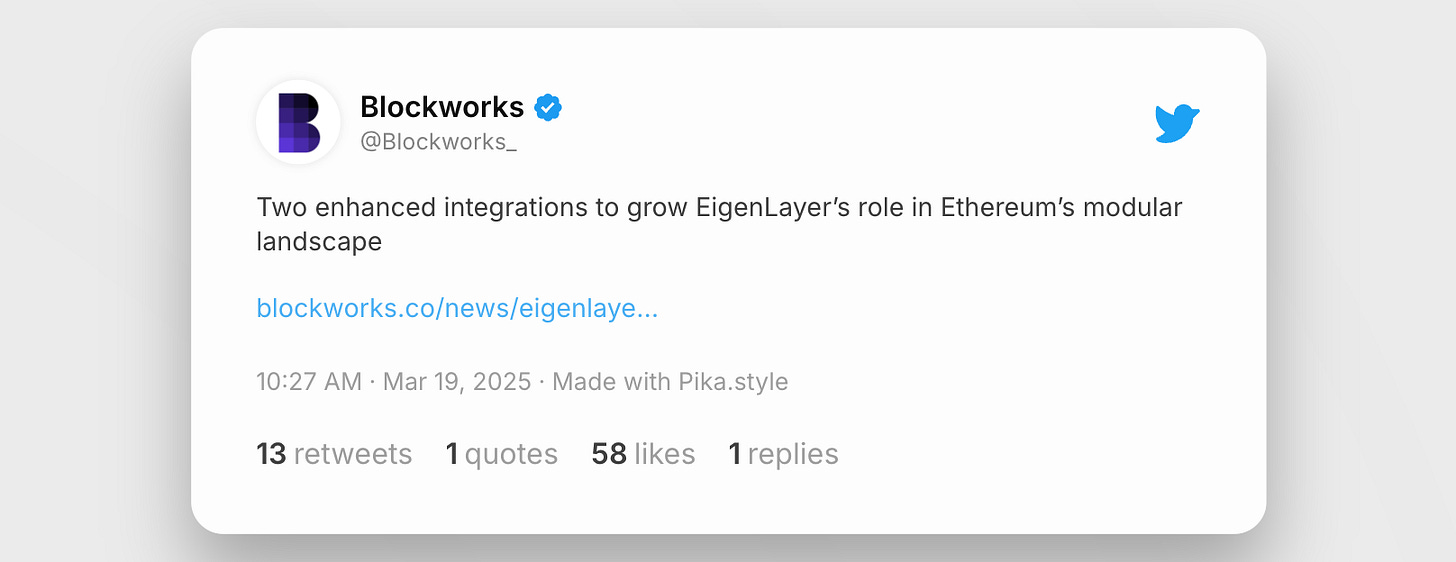Re:Staking Weekly #19
Let’s Flood the World with Verifiable Data, Lagrange Handling 75% of ZKsync’s Workload, and Mantle’s EigenLayer + EigenDA Integration
Welcome to Issue #19 of Re:Staking Weekly! 👋
This week, we’re kicking things off with a podcast recorded live at ETHDenver featuring Hersh Patel from Opacity. If you’ve been following along, you already know Opacity is something special — its rapid rise grabbed my attention a few weeks back, and this conversation filled in a lot more details about the business. Hersh opens up about the company’s candid founding story, where Opacity stands today, and the ambitious future it’s charting. It’s a packed episode — you won’t want to miss it.
Also in this issue: Lagrange handling 75% of ZKsync’s proof workload, Mantle’s EigenLayer + EigenDA integration, DataHaven joining the EigenLayer ecosystem, and more.
Let’s get into it! 🚀
Let’s Flood the World with Verifiable Data | Hersh Patel, CEO of Opacity
Hersh Patel, better known online as EulerLagrange, is the CEO of Opacity — the zkTLS company we’ve previously featured in our newsletter.
At EthDenver, I sat down with Hersh to dive deeper into the questions I had around his personal founding story, Opacity’s evolving business model, and why he believes restaking is the best economic engine for the company.
I’ve always had a soft spot for Opacity. It feels like the original ethos of Web3 — challenge the incumbents, liberate data, and reduce transaction costs. Hersh’s story is especially compelling: from reverse-engineering Uber’s API in college, to thinking his idea was impossible, to finally having that “aha moment” when it all clicked. I think you’ll enjoy this one.
Here are the key ideas Hersh shared during our conversation:
1. The Poverty of Verifiability
Early in our conversation, Hersh introduced a striking phrase that sticks to me: “the poverty of verifiability.” It captures the shocking lack of verifiable data in our digital world — not just a Web3 problem, but a foundational flaw of the internet itself, and arguably a structural issue in society.
Today, the amount of verifiable data is laughingly small. The core challenge is that we can't bring off-chain data — like your Twitter handle or whether you have $5,000 in your bank account — on-chain in a trust-minimized and verifiable way.
Oracles don’t solve this. Most meaningful data is locked behind corporate APIs, walled off from third-party access. The only real path forward, according to Hersh, is zkTLS.
Opacity’s vision is bold: flood the world with verifiable data. If successful, it can not only enable new Web3 use cases but also dramatically reduce the transaction costs that pervade real-world systems.
2. Aligning Incentives for Data Sharing
Most approaches to verifiable data assume cooperation from data providers — but in reality, companies often have zero incentive (or even disincentives) to sign and share their data.
The key breakthrough for Opacity was realizing that zkTLS lets them bypass that entirely. Instead of waiting for companies to play ball, zkTLS leverages existing HTTPS APIs — allowing verifiability without requiring any changes from the data providers themselves.
This means immediate utility without having to rebuild the internet from scratch — and a much more realistic path for a real business.
3. The Surprise Use Cases
Some of the most interesting applications of Opacity’s tech weren’t even on Hersh’s radar at the start. They emerged organically:
Daisy – TikTok influencers coordinating engagement for brand deals
Earnify – Disrupting predatory payday lending by proving work hours via payroll data
EarnOS – Enabling targeted advertising without intermediaries like Google Ads
All of these use cases share a common theme: valuable data is trapped behind intermediaries who extract rents. With verifiable data, direct and more efficient transactions become possible.
4. The SaaS Model + Restaking
Opacity takes a refreshingly simple approach to monetization — modeled closely after Plaid:
Per-user-per-month pricing
Focus on recurring revenue from high-traffic applications
Already securing major deals using this model
It’s easy for business clients to understand and adopt, which gives Opacity a strong foundation to iterate from.
This model also aligns perfectly with EigenLayer’s restaking:
Shared security is cheaper and more scalable than native token security
It enables better incentive design across multiple blockchain ecosystems
It allows for recruiting and incentivizing specific operator behavior (e.g., TEE requirements as one of the slashing conditions)
Learn More
News Bites
Lagrange's Prover Network will start to handle 75% of ZKsync's capacity, a significant milestone in adoption and usage.
DataHaven, a project built by MoonBeam (Polkadot EVM project), announces its integration with EigenLayer. The platform provides high-volume verifiable data access for smart contracts.
Human Network's identity layer will soon go live on EigenLayer mainnet, inheriting 34.5M user credential data from the Human Passport product.
Watch Nader build an MCP server that serves AVS data. This could be interesting for anyone developing verifiable agents.
Read about how EigenLayer’s go-to-market strategy is taking shape, with major wins secured on Mantle and ZKsync.
That's it for this week's newsletter! As always, feel free to send us a DM or comment directly below with your thoughts or questions.
If you want to catch up with the latest news in the restaking world, give our curated X list a follow!
See you next week and thanks for reading,






